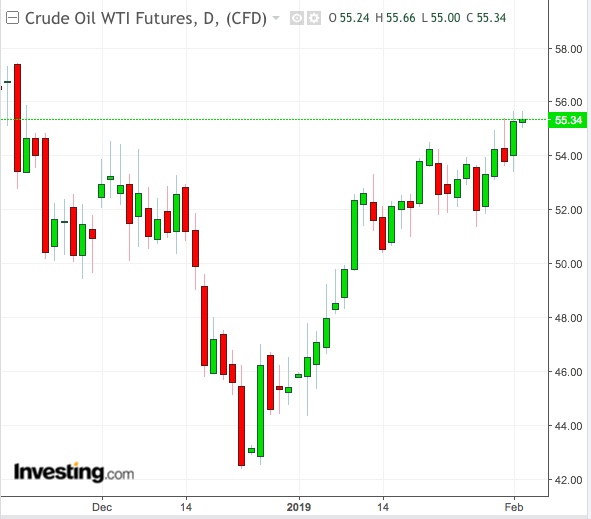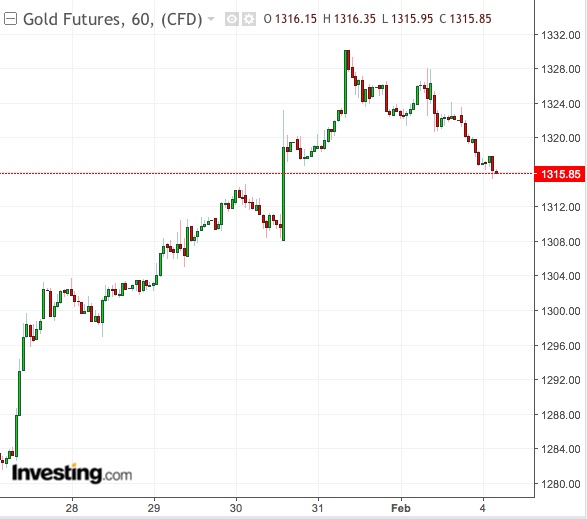That the Saudis will continue squeezing crude exports to get the dollar per barrel they want is no dispute. Neither can the positive impact to oil from a protracted Venezuelan crisis or a patient Federal Reserve be questioned.
But will shale get literally pumped up at $55 per barrel and above to neutralize all this?
That no-one can answer with certainty.
Gold's story as the ultimate beneficiary of Fed actions might be clearer though as the yellow metal broke through several layers of the $1,300 ceiling last week before it saw some profit-taking that analysts viewed as necessary for a further rally.
A number of Fed speeches will get market attention in the week ahead, as traders watch for further clues on interest rates. Topping the agenda will be remarks from Fed Chair Jerome Powell, who will be speaking on Wednesday at a town hall meeting for teachers in Washington DC.

In oil’s case, as U.S. West Texas Intermediate crude rose to 10-week highs on Friday, market bulls hit another sweet spot: the closely-watched U.S. rig count published by industry firm Baker Hughes showed a drop of 15 unit to a nine-month low of 847.
But the rig reading has also been volatile lately, rising by 10 units and falling by 21 in the previous two weeks. And while the current number may mark a nine-month low, it is still higher than a year ago, when only 765 rigs were active.
Oil Rigs Could Rise Just As They Have Fallen
A lagged but closely-watched indicator of future production, the price-sensitive rig count could move into a rising trend if WTI advances north of $55 through February. Bloomberg reported last week that transportation bottlenecks in the Permian could be reduced four months ahead of schedule due to pipeline operator Enterprise’s decision to start crude oil shipments on a converted 200,000 bpd line by as early as February.
Bank of America also estimates that three-quarters of non-shale projects over the next five years—involving crude from the North Sea to Guyana—will be profitable at just $40 oil.
Reuters suggested that last week’s rig count drop could be due to some drillers following through with plans from last year to spend less on new oil wells when crude prices were crashing to the low $40s.
But the market’s recovery since—and the parsing of latest earnings calls and profits of top U.S. energy firms in the prolific Permian shale basin—might tell a different story.
Drilling Will Be Decided By Prices: Exxon, Chevron Already Show How
During ConocoPhillips’ (NYSE:COP) earnings call on Thursday, Chairman and Chief Executive Officer Ryan Lance said the company was committed to giving 30 percent cash back to shareholders, but also commented “we'll see where the commodity price for the market is” when it comes to drilling.
It was a somewhat similar story at Exxon Mobil (NYSE:XOM) and Chevron (NYSE:CVX), two of the world's largest oil producers. Having missed the first stage of the shale boom in the Permian, they pumped a staggering total of 677,000 barrels of oil and gas per day in the fourth quarter, close to a fifth of the region's total oil production.
Both posted improved quarterly earnings on Friday, showing double-digit percentage increases in their production. Chevron, particularly, has ramped up output without giving up on high dividend payouts for its investors.
EIA Could Announce Another Record In U.S. Oil Output
Add to that data from the Energy Information Administration last week that showed U.S. oil production had hit a record 12 million barrels per day, two months ahead of expectations. The EIA, which has a 13 million bpd forecast for 2020, will likely have an updated record for this year when it issues its February dataset.
For now though, oil’s momentum is up and, barring a leap in the rig count, U.S. crude will attempt to add to February its 18.5 percent return for last month—which was the highest for any January on record. Gains could be accelerated if the U.S. and China reach a deal to end the bitter trade war between them. Year-to-date, WTI was already up more than 21 percent as Asian trading of oil began on Monday.
Gold To Take Cue From Fed Speeches, ISM Data
For investors in gold, Fed Chairman Powell’s town hall meeting on Wednesday is just one of several events that could lend direction. Other central bank speakers due to speak this week are Fed Vice Chair Richard Clarida, Cleveland Fed President Loretta Mester, St. Louis Fed President James Bullard and Fed Governor Randal Quarles, all of whom could give gold bugs more signals on whether further highs at $1,300 are possible.

Gold's five straight-day rally—the best winning streak in 17 months—came to an end on Friday, as U.S. President Donald Trump said he would try to meet his Chinese counterpart Xi Jinping for a trade deal. Investors have been buying gold either as a hedge against a further fallout with China or a bet that the trade deal would never happen.
Fed speeches aside, precious metals investors would likely look at Tuesday’s ISM survey on service sector activity for January, which is forecast to inch down to 57.0 from the previous month's reading of 57.6.
